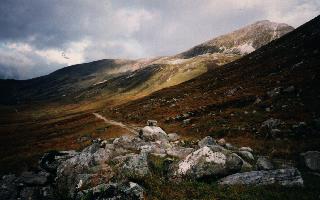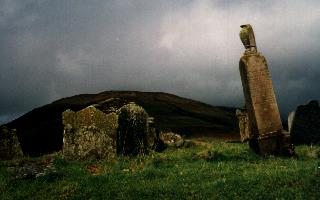West Highland Way
Key information: West Highland Way 
The West Highland Way winds its way through a huge variety of magnificent landscapes on its 95 mile course between Milngavie (near Glasgow) and Fort William.
The scenery is in places almost painfully beautiful: grand crags and purple hillsides above glens; and famous bonnie banks of Loch Lomond.
Walkopedia rating
- Walkopedia rating87.5
- Beauty31.5
- Natural interest16
- Human interest8
- Charisma32
- Negative points0
- Total rating87.5
Vital Statistics
- Length: 152km/ 95m
- 8-9 days
- Level of Difficulty: Strenuous
WALK SUMMARY
The West Highland Way (WHW), the first trail to be officially designated as a long distance route, winds its way through a huge variety of magnificent landscapes on its 95 mile course between Milngavie (near Glasgow) and Fort William. The scenery is in places almost painfully beautiful: grand crags and purple hillsides above glens; and famous bonnie banks of Loch Lomond.
The Way is demanding, but not a miserably tough enterprise.
Western Scotland has a huge variety of weather at any time of year, so always come ready for unpredictable weather.
Much of the Way follows old drovers' roads, the green ways which networked the Highlands, along which the highlanders drove their cattle to the markets of the Lowlands. These are a precious national asset. Other stretches follow old military roads, which were build by the Hanoverians as a means of suppressing the Highlands after the '45 rebellion.
You can walk the WHW in 6 days, although this would be a bit of a slog and not leave much time for exploration. Better 7 or 8 days. You can walk it south to north (most people do and a bit easier), although north to south for some sun and wind) on face is also popular.
Day walking sections of the WHW is very practicable, as it often meets roads. Your choice of day walks would depend on your aspirations, energy and determination. Most would agree that days 5 and 6 are the finest walking when all factors are taken into account.
Walking south to north, if you are aiming to do the Way in 7 days, the stages are as follows.
Day 1 - Milngavie to Drymen
A gentle 20km escape from the outskirts of Glasgow to near the foot of Loch Lomond. Not the WHW's most thrilling day, but a good leg-stretcher in gentle farmland.
Day 2 - Drymen to Rowardennan
A more demanding 24km rolling route near the famously bonnie banks of Loch Lomond. Gorgeous scenery and rich wildlife.
Day 3 - Rowardennan to Crianlarich
A long and demanding 32km day which leads steadily into the wild grandeur of the Highlands, although this is a section which can be done over two days by those wanting a more relaxed approach. Half the day will be beside the beauties of upper Loch Lomond, thereafter climbing Glen Falloch (unfortunately in the company of the A82, so significant noise pollution, and the railway line to boot), for a substantial part of the way on an old military road.
Day 4 - Crianlarich to Bridge of Orchy
This 21km stretch winds up beautiful Strath Fillan to Tyndrum, often in lovely open forest, taking in the scanty remains of St Fillan's Priory on the way. Thence a climb up a narrow, steeply dramatic glen takes you over the east-west watershed and down into the wide, flat-bottomed, gorgeous Auch Gleann with fine, conical (iconical?) Beinn Dorain ahead. A lovely tramp along on an atmospheric old military road gets to, eventually, to Bridge of Ochy. You are, unfortunately, in the aural if not always visual company of the A82 road the whole way - and the railway line, a real dampener for wilderness lovers.
Day 5 - Bridge of Orchy to Kingshouse: Rannoch Moor
A 19km crossing of the fringes of the remarkable Rannoch Moor on old drove and military roads to the head of Glen Coe.
Rannoch Moor is outstanding by any standards, a high empty plateau of hill and moorland and bog, with grand highland mountains in the background, riven by burns and littered by delightful little lochs. The valley of the River Ba, at its heart, is meltingly beautiful on a good day, and sinisterly so on a bad one. Along with Days 5 and 6, the best the WHW has to offer.
Beginning at Bridge of Orchy on the busy A82 road just below where Loch Tulla empties into to the river Orchy, you cross the river on a fine old military bridge, and have the choice of rounding the ridge ahead on a minor road (for slackers), or of climbing steadily through pretty woodland then up a grassy hillside to a really beautiful viewpoint on a ridge of Ben Invereigh, with exceptional views even by the marvellous local standards of the nearby mountains and across Loch [Tulla towards Rannoch Moor; then descend to meet the road again at Inveroran and round the end of beautiful Loch Tulla.
Then it is long stretch of rough-cobbled old road, which was built under Telford to replace the deteriorating older military road. This involves 2+ hours of gentle climbing and crossing undulating lake-sprinkled moorland. The first hour or so is interesting and attractive enough, but the visual fireworks begin as the views open up over Rannoch Moor: on a good day you can can gaze eastward for miles and miles across moorland, bog and lakelet to distant blue ridges. To your west is the thrilling hole that is Coire Ba, surrounded by cliffs and grassy hillsides. Marvellous.
You eventually reach a ridge-top and descend steadily down the flanks of steep Meall a'Bhuirdh to the brilliantly sited Kings House Hotel.
See more on this walk here, including William Mackesy’s account of walking here.
Day 6 - Kingshouse to Kinlockleven via the Devil’s Staircase
This section illustrate the WHW’s strengths and weaknesses. The first (missable) hour traverses a flank of upper Glen Coe on an old military road, in staggering scenery but never out of earshot of, and sometimes right beside, the endlessly busy A82 road.
The trail then turns north, up a long hillside of grass and heather which becomes the not wildly demanding zig-zag known as the Devil's Staircase. The road is by now a minor blot on the huge and wonderful glen. From a low pass in the ridge, you are gazing on a new landscape to the north, across the deep Leven valley to a wonderful series of ridges and summits, scooped back into fine corries. Behind them looms the high, bleak, flat top of one of Ben Nevis' close neighbours. You descend gently on a good path, winding around the mountain sides for some way. To the north-east, a long, wide, high, treeless valley appears, with the beginnings of huge and strange Rannoch Moor at its far end and a shallow-looking reservoir in its bottom. The trail then enters sparklingly pretty birch woods, and joins a steep track in the woodlands, dropping pleasantly enough to Kinlockleven village. A relatively easy 14km.
See more on this walk here, including William Mackesy’s account of walking here.
Day 7 - Kinlochleven to Fort William
A long (22+km) but fine day, much of it approaching then following the lovely, lonely, hidden Lairig Mor glen on another stretch of old military road. A final crossing of hills takes you to Glen Nevis and the final walk-in to Fort William. Bravo!!
_____________________________
Our friends the Oranginas walking group from the Netherlands have also walked the famous trail. Here’s what they had to say:
“Thousands of walkers, endless information on the internet…..it must be the exceptional beauty of the Way. We started our trail at Crianlarich, leaving behind Milngavie (Glasgow) and Loch Lomond. There is a train connection between Glasgow and Fort William, the end of the West Highland-way. So, in fact you can start everywhere, the train follows the route. A well way-marked trail.”
THANK YOU ORANGINAS! See their full account here
Other accounts: share your experiences
Your comments on this walk, your experiences and suggestions, and your photos are very welcome. Where appropriate, you will be credited for your contribution.

We have a lot of helpful practical information and tips about this walk, covering everything from the best books and maps, to timing and weather, geting there, possible problems, whether you need a guide and where to find them, and useful websites. This section is only open to members.
Membership is FREE AND JOINING TAKES 30 SECONDS. To login or sign up click here
Safety and problems: All walks have inherent risks and potential problems, and many of the walks featured on this website involve significant risks, dangers and problems. Problems of any sort can arise on any walk. This website does not purport to identify any (or all) actual or potential risks, dangers and problems that may relate to any particular walk.
Any person who is considering undertaking this walk should do careful research and make their own assessment of the risks, dangers and possible problems involved. They should also go to “Important information” for further important information.
Anyone planning an expedition to this place should see further important information about this walk.
Safety and problems: All walks have inherent risks and potential problems, and many of the walks featured on this website involve significant risks, dangers and problems. Problems of any sort can arise on any walk. This website does not purport to identify any (or all) actual or potential risks, dangers and problems that may relate to any particular walk.
Any person who is considering undertaking this walk should do careful research and make their own assessment of the risks, dangers and possible problems involved. They should also go to “Important information” for further important information.
COMMUNITY COMMENTS AND PHOTOS
Name: Administrator
Posted on: 27/08/2012
The following is Simon Whaley's piece on walking here, which was on our longlist for our 2011 Travel Writing Competition.
Seven small events that made his walk along Scotland�s West Highland Way so memorable.
Seven Day Wonder
Every great journey should begin with a jumbo sausage roll. Flaky pastry crumbs provide extra sustenance for negotiating nasty clumps of gorse bushes in Mugdock Country Park. But there is more to the West Highland Way long distance footpath than sausage rolls and gorse bushes. People focus on the big wonders; Loch Lomond, Glen Coe, Ben Nevis. For me though, it offered seven days of amazing, small wonders.
Day One
Conquering Conic Hill�s 1200-foot summit is not taxing, or even enduring, unless it marks the end of a long, tiring, 20-mile first day. The muscle motivating view uplifted my spirits to a far higher altitude. In the calm, evening light, Loch Lomond�s islands were molehills in a golf green, or stepping-stones to the Arrochar Alps. Glancing left, I watched the windows of Glasgow�s tower blocks dazzle in the fading evening sun. Leering to the right enabled me to see into the future � well � the next three days. The Highland Boundary Fault beckoned, drawing me magnetically, ever closer to Fort William. That was the small wonder of Conic Hill. Conquering it inspired me to reach my journey�s end.
Day Two
Rob Roy�s Cave was an unexpected wonder. There is nothing cavernous about this crevice. In fact, it is so small it�s easily missed if it weren�t for the word �CAVE� daubed on an adjacent rock. I give it small wonder status because of its historical qualities. My fingers read the rock face. History in braille. Every nook, cranny, serrated edge and weather-beaten face reputedly witnessed the legend that was Raibeart Ruadh, to use his Gaelic name. Here, the valley narrows. The slopes of Beinn a Choin and Little Hills squeeze Lomond�s waters to lap at the Way as it traverses this rocky, tree-root strewn section. There are no sanitised country parks now. The two-day-old bristles on my face tightened. A breeze flew across the water and the crags around Rob Roy�s Cave nicked my finger. I shuddered. It was as though hundreds of eyes through history were watching my every step.
Day Three
Gravestones. I defy anyone standing on the West Highland Way between Kirkton Farm and Auchtertyre not to marvel at the optimistic patch of sloping ground, surrounded by a dry stone wall. Optimistic, for its sheer size and relative emptiness. This slice of heaven won�t fill up; the locals abandoned it eighty years ago. For the first time since Milngavie, I felt alive, ironically. This final resting place stole my heart. It would have to wait for the rest of my body, though!
Day Four
Under the auspices of a headless Beinn Odhar, with a thick, low cloud scarf around its neck, I encountered the West Highland Way height restriction. A cattle creep under the West Highland Railway Line. Bending down brought my nose closer to the floor, clarifying that cattle clear their bowels whilst creeping. My head cleared the roof, but my rucksack wedged tightly against the concrete blocks supporting the railway line above.
A low rumbling noise penetrated my thoughts. The puddles at my feet danced. The rumbling crescendoed. My eardrums throbbed. Fear engulfed me. I lunged forwards, then backwards, forwards, backwards, but my rucksack was rammed fast against the ceiling. St Fillan�s graveyard was a beautiful experience, but I wasn�t ready for it yet. My survival instinct kicked in. Unbuckling the waist strap, I dragged my arms from the shoulder straps, lurched forwards, through the metal gate and out into the open, fresh air. Turning around, I watched the bogeys of the two-carriage Sprinter train clatter by, hurtling towards Tyndrum. Underneath, my rucksack swung nonchalantly, before suddenly, plummeting into the cattle creep mess. If a �wonder� is something unexpected, then this cattle creep was certainly an unexpected experience.
Day Five
Weather forecasters are put through their paces on Rannoch Moor. This wilderness experiences every form of weather possible within a matter of hours. Submerged trees rose menacingly from lochs, adapting to survive in this harsh environment. Even Mother Nature fights to subsist here. Crossing this 13-mile section of open, windswept, bog deserved respect, although this is not my wonder, for it is not small. Near the end of the day�s passage lies the most photographed mountain in Scotland. Buachaille Etive Mhor. Majestic. Imposing. Foreboding. But, my wonder was snuggled at its foot, occasionally slipping into the odd photo too.
Blackrock Cottage�s white-washed, stone walls with reddish-brown doors squat assuredly on the moor�s edge, hugging the ground: it�s roof barely a few feet from the soil. Two diminutive chimneys stab the sky. After crossing that inhospitable moor, its sight raises morale. A sign of civilisation. My spirits experienced sheer wonderment that the unmitigated beauty of Rannoch Moor gave someone journeying across this inhospitable land centuries ago, enough courage and determination to build a shelter here. Rannoch is a wonder in its own right, but striding closer to the Kingshouse Hotel, I marvelled at the wonder of Blackrock Cottage�s builders.
Day Six
Way walkers have two common goals. To complete the route and to get a good night�s sleep. Having climbed the Devil�s Staircase and clambered high across the mountains to Kinlochleven, it was with weary legs that I dropped into the town�s bunkhouse. I was sharing a small room with a father and son team. His ex-army mannerisms relished this 95-mile challenge, whereas his 16-year-old son�s lack of effort suggested he was enduring the family tradition his two older brothers had already undertaken. There were also thirty under-11s sharing the bunkhouse, busy re-enacting the Glencoe Massacre. Despite starting at 3pm, by 12.30am they still hadn�t finished. Gut-wrenching screams, rallying-warrior cries and shuddering walls penetrated our twin bunk-bedded room. At 12.38am, Military Dad opened the door and bellowed so loudly, both sides of the Glencoe Massacre hit the decks, never to move again until after I�d left later that morning. It was the best night�s sleep all week. I never saw Military Dad, or his son, again, but his ability to silence thirty children with one bellow is a wonder I shall not forget.
Day Seven
OTHER ACCOUNTS
share your experiences
Add your experiences, suggestions and photos. We would be delighted to receive your writing and ideas (which will be attributed appropriately where published).
Anyone planning an expedition to this place should see further important information about this walk.
Responsible travel matters, a lot. How you travel will make a real difference - for better or worse. PLEASE consider this when making plans. Read more











